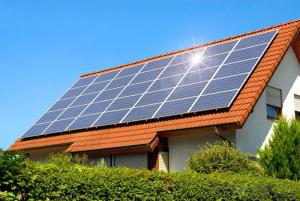260watt CNBM Solar Polycrystalline Series II (250W—260W)
- Loading Port:
- China main port
- Payment Terms:
- TT OR LC
- Min Order Qty:
- 10000 watt
- Supply Capability:
- 500000 watt/month
OKorder Service Pledge
OKorder Financial Service
You Might Also Like
Item specifice
CNBM Solar Polycrystalline Series II (250W—260W)
Characteristics
Max Power Voltage Vmp(V) | 30.1 | 30.4 | 30.5 |
Max Power Current Imp(A) | 8.31 | 8.39 | 8.53 |
Open Circuit Voltage Voc(V) | 37.4 | 37.5 | 37.6 |
Short Circuit Current Isc(A) | 8.83 | 8.86 | 8.95 |
Max Power Pm(W) | 250 | 255 | 260 |
Temperature Coefficient of Cells
NOCT | 45℃±2℃ | |
Temperature Coefficients of Isc (%/℃) | - 0.049 | |
Temperature Coefficients of Voc (%/℃) | –0.32 | |
Temperature Coefficients of Pmp (%/℃) | –0.43 | |
Mechanical Data
Dimension | 1638 x 982 x 40 mm | |
Weight | 19.5kg | |
No. of Cells and Connections | 60 (6 x 10) | |
Tolerance | 0~+5W | |
Cell Monocrystalline Cell | 156 x 156 mm | |
Packing | 700 Pcs/40ft(H) Container | |
Limits
Operating Temperature | –40 °C to +85°C | |
Storage Temperature | –40 °C to +85°C | |
Max System Voltage | 1000VDC(IEC) / 600VDC(UL) | |
IV Curve

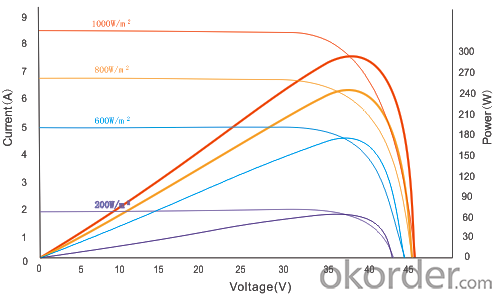
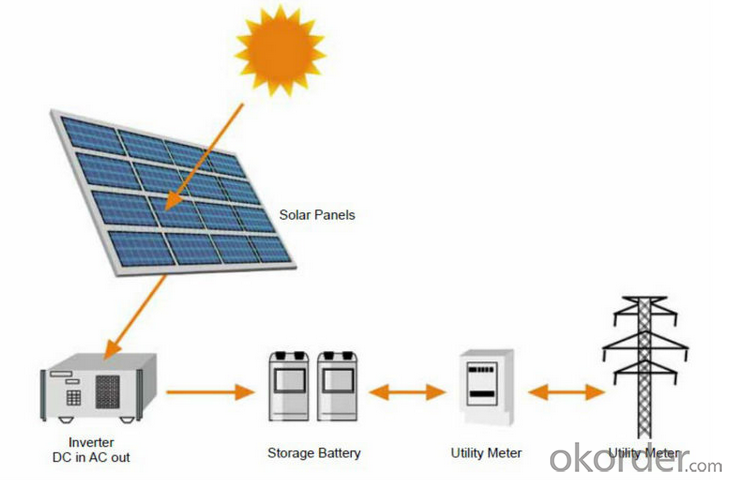
Image
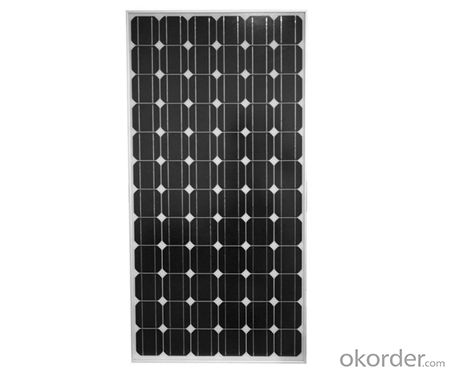
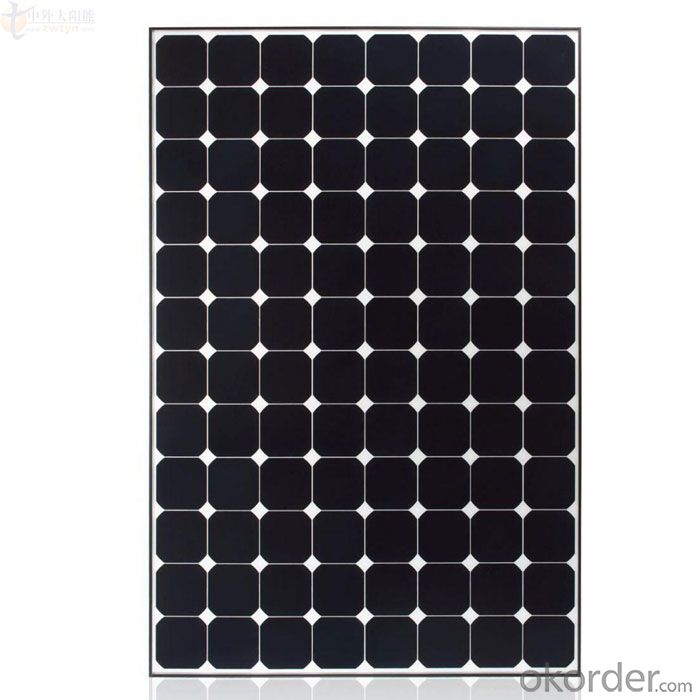
Guarantees
Products Guarantee 12 yrs free from defects in materials and workmanship
Performance Guarantee No less than 90% within 10yrs and no less than 80% within 25yrs
Certificates TUV (IEC61215&IEC61730), VDE(IEC61215&IEC61730), UL, CE
FAQ
1. Q: Do you have your own factory?
A: Yes, we have. Our factory located in Jiangsu province.
2. Q: How can I visit your factory?
A: Before you take off from your country, please let us know. We will show you the way, or arrange time to pick you up if possible.
3. Q: Do you provide free sample?
A: Usually we do not offer free sample
4. Q: Could you print our company LOGO on the nameplate and package?
A: Yes, we can do that.
- Q:I need a list of worldwide solar panel manufactures from china, US, Spain, Germany, Japan etc...Can any one direct ne to such place?I rather it will also contain comparison of parameters like efficiacy, quality etc and to be divedied by country of manufacturing.Thank you
- Actually Ofir, it is much easier and less expensive than you might believe. What you need is a magazine, like, Solar Today. There is only one that I am familiar with that gets into the nuts and bolts of solar panel manufacturers, installation, and other types of renewable energy. It's called, Home Power Magazine. We have a home that has been powered by the wind and sun for the last 0 years or so, and most of our initial information came from Home Power, and afterward, from many of the sources that they have in their articles. Every few issures, they take an item connected to renewable energy, such as an inverter, wind turbine, water turbine, or solar panel, and list all the different models that are available. They are broken down by manufacturer, and include specifications like power output, range of voltages, efficiency, materials, and even where they are manufactured. If you subscribe online for one year, the cost is around $25 USD, you will have access to all the previous issues that are archived on their website. You can use their search engine to locate an article listing all the solar panels, they did one a year or so ago with all the information you are looking for. Despite what you might be hearing, solar power usage is growing at an incredible rate. In the US alone, there are over 00,000 homes and businesses operating some level of solar power right now, that's good news. As far as different countries using different requirements, most all of the manufacturers today are selling their products to most countries worldwide, they are designed to meet requirements for almost anyplace you might use them. Check the magazine out today, you might learn more than you were originally looking for. I will include their link below, and some other good sources for information. You can google any one of them to find their website. Good luck, and take care...Rudydoo
- Q:Can solar panels be used for powering water treatment plants?
- Yes, solar panels can be used for powering water treatment plants. Solar energy can be harnessed to generate electricity, which can then be used to power the various processes and equipment involved in water treatment plants. This environmentally-friendly approach helps reduce reliance on fossil fuels and contributes to sustainable water management practices.
- Q:Do solar panels require a specific type of inverter for converting DC to AC power?
- Yes, solar panels require a specific type of inverter known as a solar inverter to convert the direct current (DC) power produced by the panels into alternating current (AC) power that can be used in households or fed into the electric grid.
- Q:How do solar panels affect the overall comfort of a building?
- Solar panels can positively impact the overall comfort of a building by reducing energy costs, improving indoor air quality, and providing a more reliable and sustainable source of electricity.
- Q:Do solar panels require a backup battery system?
- No, solar panels do not necessarily require a backup battery system. However, having a battery system can be beneficial as it allows for the storage of excess energy produced by the solar panels, which can be used during times when there is no sunlight or during power outages.
- Q:i check the diodes in the backside of solar panels it reads out to be 0.433 each give me the same result but i was amazed when i check out the last two one which on clamp meter screen give me ''0L'' what this means? is that diode have malfunctions??is this reasons that the output of solar has been decreased?
- First of all, make sure that you are taking readings in the dark (with the solar panel indoors and covered). 0.433 is a reasonable forward voltage for a Schottky diode. Ideally, it diode should read open one way (possibly OL for your meter), and 0.4 the other way. If it's reading OL both ways, the diode is bad. You can either unsolder it or cut it out and verify that it is bad.
- Q:We want make solar panel for our home use. but we have no any right idea how we can make it. we want to make it with cheap prices.we also want to know the proper size of solar panel.where we can take help about making a solar panel
- Create okorder
- Q:Can solar panels be installed on a residential community or housing complex?
- Yes, solar panels can be installed on a residential community or housing complex. In fact, many residential communities and housing complexes are now opting for solar panel installations to generate clean and renewable energy. This not only helps reduce electricity costs for homeowners but also contributes to a more sustainable and eco-friendly environment.
- Q:I'm curious to know if the small solar panels on a calculator (ie TI-32) could produce a voltage similar to what is used in a single-use (disposable) camera, approximately 4V.
- Wrong forum
- Q:How do solar panels affect the grid during times of high electricity demand?
- Solar panels can help alleviate the strain on the grid during times of high electricity demand by generating clean and renewable energy directly from the sun. When solar panels produce surplus electricity, it can be fed back into the grid, increasing its supply and reducing the need for traditional power sources. This helps stabilize the grid and meet the increased demand while also reducing the reliance on fossil fuel-based power plants.
1. Manufacturer Overview |
|
|---|---|
| Location | |
| Year Established | |
| Annual Output Value | |
| Main Markets | |
| Company Certifications | |
2. Manufacturer Certificates |
|
|---|---|
| a) Certification Name | |
| Range | |
| Reference | |
| Validity Period | |
3. Manufacturer Capability |
|
|---|---|
| a)Trade Capacity | |
| Nearest Port | |
| Export Percentage | |
| No.of Employees in Trade Department | |
| Language Spoken: | |
| b)Factory Information | |
| Factory Size: | |
| No. of Production Lines | |
| Contract Manufacturing | |
| Product Price Range | |
Send your message to us
260watt CNBM Solar Polycrystalline Series II (250W—260W)
- Loading Port:
- China main port
- Payment Terms:
- TT OR LC
- Min Order Qty:
- 10000 watt
- Supply Capability:
- 500000 watt/month
OKorder Service Pledge
OKorder Financial Service
Similar products
New products
Hot products
Related keywords
